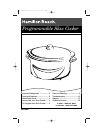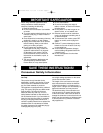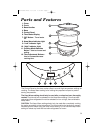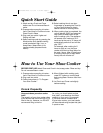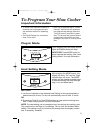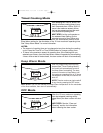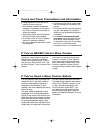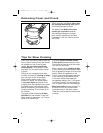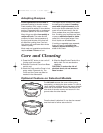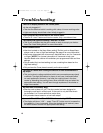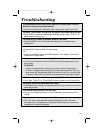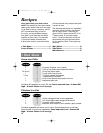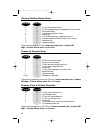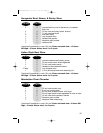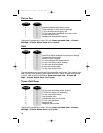
7
• Please handle the Crock and Cover
carefully to ensure long life.
• Avoid sudden, extreme temperature
changes. For example, do not place a
hot Cover or Crock into cold water, or
onto a wet surface.
• Avoid hitting Crock and Cover against
the faucet or other hard surfaces.
• Do not use Crock or Cover if chipped,
cracked, or severely scratched.
• Do not use abrasive cleansers or metal
scouring pads.
Crock and Cover Precautions and Information
• The bottom of the Crock is very rough
and can damage the countertop. Use
caution.
• The Crock and the Cover can become
very hot. Use caution. Do not place
directly on any unprotected surface or
countertop.
• The Crock is microwave safe and
oven proof, but never heat the Crock
when empty. Never place the Crock
on a burner or stove top. Do not place
the Cover in a microwave oven,
conventional oven, or on the stove top.
Cooking in a slow cooker is easy but
different from conventional methods.
Take a few minutes and read “How to
Use Use Your Slow Cooker” and “Tips
for Slow Cooking.” Then try some of the
recipes.
You’ll soon be convinced that a slow
cooker is a necessity. There are also
many slow cooker recipe books avail-
able in the library or book store. If you
have any questions, call our toll-free
customer service number. We’ll be glad
to help.
If You’ve NEVER Used a Slow Cooker
You are probably ready to develop new
recipes for use in your slow cooker. If
the recipe was originally cooked in a
saucepan on the stovetop, or slow
roasted in the oven, adapting the recipe
should be easy.
This slow cooker is designed to bring
ingredients up to cooking temperature
quickly. It may reach a full boil and cook
faster than other slow cookers you have
used. Because the slow cooker reaches
its cooking temperature rapidly, older
recipes may need to be adjusted. Some
recipes may now take less cooking time.
If You’ve Used a Slow Cooker Before
Our slow cooker heats from the sides.
The Base slowly raises the temperature
of the Crock. Whether cooked on Low
or High, the final temperature of the
food is the same, about 200°F. The
only difference is the amount of time
the cooking process takes. Read the
section on “Adapting Recipes” for more
information.
840105900 Ev06 2/17/03 1:56 PM Page 7



